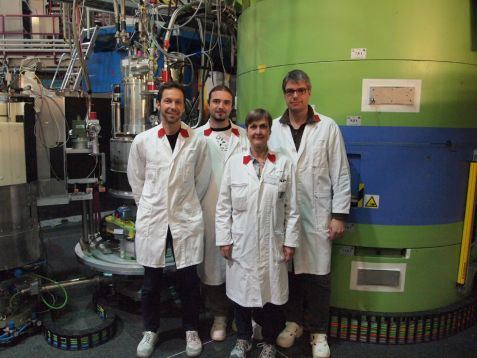MLZ is a cooperation between:
 > Technische Universität München
> Technische Universität München > Helmholtz-Zentrum Hereon
> Helmholtz-Zentrum Hereon
 > Forschungszentrum Jülich
> Forschungszentrum Jülich
MLZ is a member of:
 > LENS
> LENS > ERF-AISBL
> ERF-AISBL
MLZ on social media:

MLZ (eng)
Lichtenbergstr.1
85748 Garching
02.05.2019
Exceptions become the rule

Dr. Astrid Schneidewind at the neutron three axes spectrometer PANDA, that is operated by Forschungszentrum Jülich at the Heinz Maier-Leibnitz Zentrum in Garching. © Wolfgang Filser / TUM
Electrons and their atomic nuclei influence their respective motions in more materials than previously assumed. Scientists from the Technical University of Munich (TUM) and the Forschungszentrum Jülich made this discovery during measurements conducted at TUM’s research neutron source Heinz Maier-Leibnitz (FRM II). Possible applications for the effect they identified include data processing and zero-loss transmission of electricity.
It was purely by chance that students carrying out a practical experiment at TUM’s research neutron source (FRM II) challenged the limits of the Born-Oppenheimer approximation, a cornerstone of physics established by nearly a century of research. Dr. Astrid Schneidewind needed a specimen for her practical experiment with neutrons. Her colleague, TUM scientist Dr. Christian Franz, had just succeeded in growing a large crystal of a new compound for the first time. Motivated by experiments on similar substances, she let the students test the CeAuAl3 specimen for unusual excitations. Other researchers had already unsuccessfully investigated the material in powder form on different spectrometers.

Electrons (green) influence the lattice vibration (pink waves) of the crystal and vice versa. Golden balls represent the Cerium atoms, which mainly cause the magnetism of the crystal under examination © Dr. Petr Čermák / Karls-Universität Prag
A chance discovery
Although they weren’t expecting any particularly exciting results from the experiment, the physicists from Forschungszentrum Jülich went ahead and placed the crystal in their neutron triple-axis spectrometer PANDA for overnight analysis. A major surprise awaited them the next morning when Schneidewind’s colleague Dr. Petr Čermák, at the time a postdoc researcher at Forschungszentrum Jülich, looked at the results of the measurements with the students. They revealed couplings between the motions of atomic nuclei and the electrons, which should have been impossible according to the Born-Oppenheimer approximation. Extensive measurements confirmed the initial results, with Čermák using PANDA and the neutron triple-axis spectrometer PUMA to substantiate the observations over a period of several years.

The scientists involved in front of the neutron three axes spectrometer PANDA at the Heinz Maier-Leibnitz Zentrum in Garching (from the left): Dr. Christian Franz (TUM), Dr. Petr Čermák (Charles University Prague, former Forschungszentrum Jülich), Dr. Astrid Schneidewind (Forschungszentrum Jülich) and Prof. Dr. Christian Pfleiderer (TUM). © FRM II / TUM
Applications for storage media and superconduction
Dating from 1927, the Born-Oppenheimer approximation is a cornerstone of physics. It assumes that the motions of the atomic nuclei and electrons in condensed systems of atoms may be treated separately and do not influence each other because of the particles’ vast difference in mass. Over time, researchers have continued to discover exotic materials or states for which this approximation did not apply. “We have now proven for the first time that such couplings between the electrons and their atomic nuclei in solids must exist in many more materials than we previously assumed,” says Christian Pfleiderer, Professor for the Topology of Correlated Systems at TUM, who helped to interpret the measurement results. “At the same time, these couplings pave the way for a wide range of possible forms of electronic order and functionalities.”
“This unexpected coupling between the atomic nucleus and its shell open up many potential fields of application, including for data processing,” according to Dr. Petr Čermák, currently a scientist at Charles University in Prague. The materials should also provide useful insights into the workings of superconduction.
Original publication
Petr Čermák, Astrid Schneidewind, Benqiong Liu, Michael Marek Koza, Christian Franz, Rudolf Schönmann, Oleg Sobolev, and Christian Pfleiderer: Magnetoelastic hybrid excitations in CeAuAl3, PNAS (published ahead of print March 20, 2019), DOI: 10.1073/pnas.1819664116
Contact
Dr. Astrid Schneidewind
Jülich Centre for Neutron Science,
Outstation at the Heinz Maier-Leibnitz Zentrum
Tel.: +49 89 289-14749
Email: a.schneidewind@fz-juelich.de
Prof. Dr. Christian Pfleiderer
Technical University of Munich
Chair of Topology of Correlated Systems
Tel.: +49 89 289 – 14720
Email: christian.pfleiderer@tum.de
More Information
News release of the Charles-University Prague
Jülich Centre for Neutron Science
MLZ is a cooperation between:
 > Technische Universität München
> Technische Universität München > Helmholtz-Zentrum Hereon
> Helmholtz-Zentrum Hereon
 > Forschungszentrum Jülich
> Forschungszentrum Jülich
MLZ is a member of:
 > LENS
> LENS > ERF-AISBL
> ERF-AISBL
MLZ on social media:


